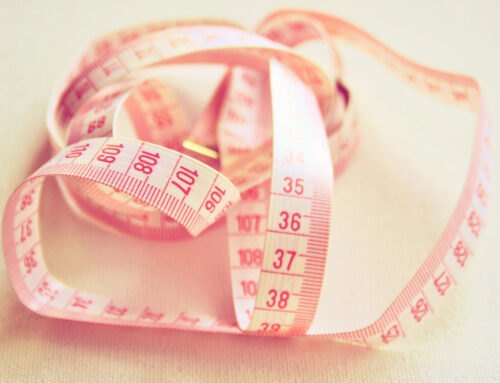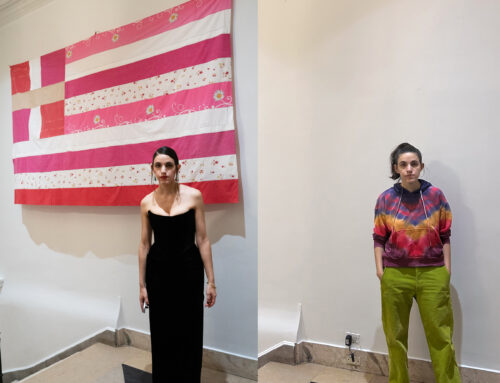Even on a cold and rainy November afternoon, Tired Thrift is packed with 20-something girls that look straight out of an early 2000s teen rom-com. Channeling their inner Paris Hiltons and Devon Aokis, they have all shown up in their most stylish outfits, reveling in the fashion show that is a casual shopping day in Greenpoint, Brooklyn.
Tired Thrift’s bubblegum pink and sage green interior is crammed with Y2K-inspired clothes that represent Gen-Z’s favorite trends. A vintage light peach Bebe tank hangs temptingly on the left rack with a $45 price tag, seemingly a steal next to the tan suede penny lane coat with fur trim for $150.

Inside Tired Thrift in Greenpoint, Brooklyn. | Image: @tiredthrift on Instagram
Founded by cousins Elona and Lediona Zharkhu in late 2020, the store is one of several curated thrift stores across New York City that stocks the shelves by reselling secondhand clothes. Whether originally found at Goodwill or an estate sale, the clothes have been curated and put back on the market, usually with a considerable markup.
Curated thrift stores have become more popular along with the explosion of shopping secondhand in recent years. Applauded for being more affordable and environmentally conscious than traditional retail, 244 million shoppers in North America embraced buying secondhand in 2021, according to online consignment store ThredUp’s 2022 Resale Report.
The report also reveals a different connotation surrounding wearing used clothing. In 2022, 74 percent of secondhand shoppers said the practice is more socially acceptable now than it was 5 years ago. It’s become cool, even, with 59 percent of those who bought secondhand for the first time in 2021 saying it gives them bragging rights.
The growth of this movement, however, isn’t enough to put a dent in the quantity of clothing being donated. The average American throws away 81 pounds of clothing every year, one of the fastest-growing waste streams, according to NY State’s Department of Environmental Conservation. Large-scale thrift charities receive more donations than could ever be sold, and there aren’t enough buyers for the unwanted items in people’s closets.
So, everyday shoppers may not have the energy or patience to spend hours searching through racks for a special find. In comes the role of the reseller, who sifts through hundreds of items looking for pieces with resale (and markup) potential. Resellers spend 40 hours a week traveling to different stores and yard sales to source, repair, and price products.
Lexi Aragon, a long-time thrifter and employee at AuH20 (Goldwater) Thriftique in Manhattan’s East Village, scours the Goodwill Outlet in Queens for the material. She digs through bins full of clothes, looking for interesting patterns and nice materials that would otherwise be destined for landfills.

Image: Lexi Aragon
“I love the search and finding a gem,” she says. “It’s a different kind of thrill when I look through a bunch of items and then find the one thing that’s really cool in a pile of rubbish.”
Enjoying the process doesn’t mean it’s easy. While a shopper might get lucky in a typical thrift store and find the perfect piece, there’s a high likelihood they’ll walk out with nothing, says Aragon. A curated store, on the other hand, offers those great finds laid out neatly. Along with the piece itself, a customer is paying for the convenience, she says.
Mary Kate Farley, a fashion historian and archivist, understands the premium placed on curated pieces. With the work and research that goes into finding historical, aesthetically compelling items in pristine condition, they’re regarded as collectibles. Additionally, archival fashion is seen as artistic and rarified, but it’s more accessible than fine art or antiques, she says. And unlike something that hangs on a wall or sits on a shelf, clothing can be worn and interacted with every day.
“People now regard fashion with the same authority as music or visual arts instead of as something frivolous,” she says. “They appreciate the work of creating fashion – the performance, fantasy, and concept that goes into it like other creative disciplines.”
Through online marketplaces and social media, the masses have caught on to the concept of reselling thrifted clothes at a markup. Sellers everywhere have started doing so on sites like Depop and Poshmark. Some thrift stores themselves have even joined in, like this Salvation Army in Atlanta that upsells its premium items on eBay.
This role hasn’t come without criticism, however. There are countless TikToks and articles published calling out resellers for excessively buying good items and contributing to higher prices at secondhand stores. These frustrations also highlight that the rise of thrifting has come with a transformation of what’s now offered on the racks.
Mwagíra Muriithi, an NYC-based stylist and fashion designer, made secondhand a staple of her wardrobe while growing up in Nairobi, Kenya. Though now, it’s been more difficult to find quality items in an overflowing sea of junk, she says. Fast fashion overwhelms the traditional thrift stores she’s always frequented.
“Everyone has valid reasons why they buy secondhand, luxury, and even fast-fashion,” she says. “I believe the real issue is our culture of overconsumption, which is becoming deeply embedded into society and a hard habit to change.”
Buying hundreds of dollars of Shein clothing that will likely get donated after a few wears is ridiculous, says Muriithi, who has come across many exorbitant clothing hauls that plague social media. Last year, ThredUp had a 186 percent increase since 2020 in the number of items listed from the fast-fashion conglomerate.
Rachel Elspeth Gross, a fashion writer and historian, celebrates that people have become more aware of the evils of fast-fashion clothing production. Only so much profit can be wrung out of production before it becomes unsustainable, she says, and with fast fashion, that threshold has been long surpassed.
“Mass-produced clothing has only existed for just over a hundred years. Before then, secondhand clothes were for everybody who wasn’t extremely wealthy,” says Gross. “As the trending sleeves or bodices changed, clothes were modified, they were remade and redone.”
So, while thrift shopping is really nothing new, upcycling clothing that’s exited the trend cycle is no longer mainstream. As such, buying something that won’t fall apart after a few wears is worth the investment, she says, and there’s so much well-made clothing already on the planet. Through more mindful purchases, shoppers can avoid accumulating unneeded items that end up tossed by the year’s end.
Donating unwanted clothes seems like a straightforward solution. But with so many donations coming in, what isn’t purchased, exported overseas, or recycled gets thrown away. In 2018, over 11 thousand tons of textiles were sent to landfills, according to the US Environmental Protection Agency.
Seth Antonio Laxman, an environmental justice and sustainability expert, says there’s no such thing as getting rid of something. It goes somewhere, and it stays there. Fast fashion is a crisis created by western capitalism to maximize revenue and profit, partnering with advertisers to create a feeling of lack, he says.
“The first thing I say when talking about sustainable options for purchasing is the best thing you can do is not buy anything,” says Laxman. But when it’s necessary, committing to purchases and buying something that will last – both in quality and stylishness – is the best option. This way, the cycle of buying fast fashion and donating it after it’s no longer wanted can be avoided, preventing the oversaturation of junk in secondhand markets.
There are just too many clothes being sent to the thrift store for resellers to pick out everything good, says Laxman, and there will always be more affordable options remaining for people who need them. Regardless of whether a piece is found at a large-scale thrifting chain or a curated shop, buying secondhand is better than buying something new.
“I’d rather someone spend $150 on a vintage leather jacket that will last them 50 years, than feed into brands that are perpetuating these toxic systems that make people want to buy so much stuff.”



